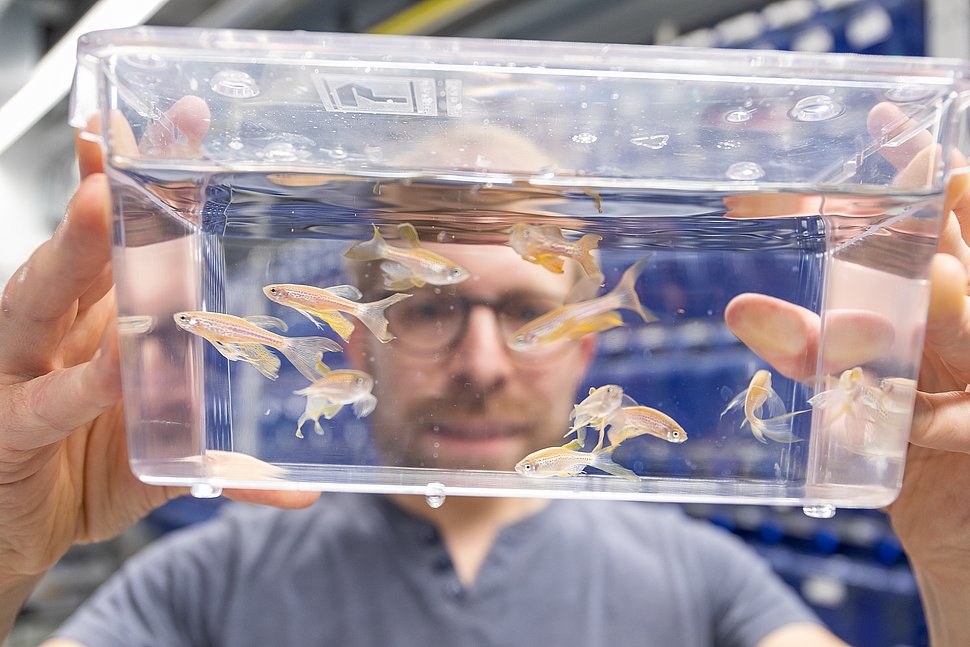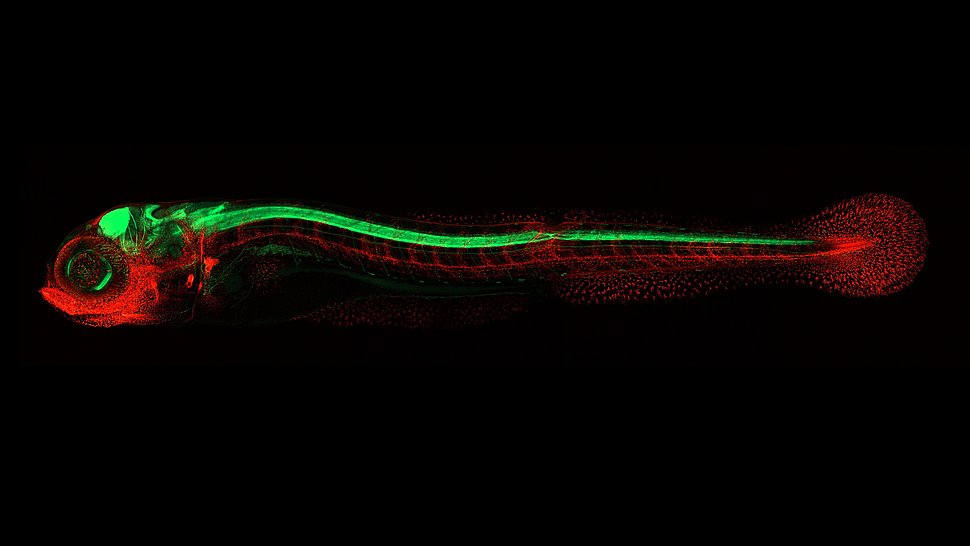Laboratory Animal Day - Zebrafish at MPL
The 24th of April is World Day for Laboratory Animals and we would like to take this opportunity to introduce the zebrafish Danio rerio, which makes an important contribution to our biophysical and biomedical research at the Max Planck Institute for the Science of Light.

Photo: MPL (1)

Photo: MPL (2)
Since 2019, we have been keeping zebrafish at the Max Planck Institute for the Science of Light. At the moment, it is about 3000 fish; the laboratories of the institute are equipped for a total capacity of over 7000 animals. It is a modern zebrafish keeping facility, which is state of the art in order to keep conditions for the animals constant and optimal. But why zebrafish? And what contribution can fish make to our cutting-edge research at MPL?
Zebrafish are frugal and undemanding. Practically every child knows this - at least if they have ever had their own aquarium with fish. Since the beginning of the 20th century, these the small, about two to three centimeters long have been among the most popular ornamental fish and millions of them swim in aquariums all over the world.
What we can learn from the self-healing wonder fish
Two factors are of particular interest for research at MPL:
1) Zebrafish develop outside the mother and are nearly transparent in the early life stages. This makes them very accessible optically, and it is possible to study tissue formation during embryonic development non-invasively, in the living animal, using state-of-the-art imaging techniques, some of which are being developed here at MPL.
2) Zebrafish, unlike humans, have the amazing ability to regenerate organs damaged by disease or injury - that is, to restore their function. If, for example, the nerve tracts in the spine of a human are damaged, this can lead to lifelong paralysis in the worst case. This is quite different from zebrafish: If their spinal cord is injured, regrowing nerves can bridge the gap. After some time, the fish can swim again.
Daniel Wehner heads the Neuroregeneration Research Group in Director Jochen Guck's Department of Biological Optomechanics. He and his team are researching the astonishing ability of zebrafish to regenerate their spinal cord that was mentioned above. To do this, they use state-of-the-art imaging techniques such as Brillouin microscopy. Their long-term goal is to use their research to open up new therapeutic opportunities, for example for paraplegics.
The institute employs three staff members who specifically look after the needs and welfare of the zebrafish, in collaboration with the scientists in charge. In addition, a veterinarian assists them in an advisory capacity. Animal experiments are subject to strict conditions and legal regulations in Germany.
Interesting facts about the zebrafish
Zebrafish are easier to keep than more complex animals, such as rodents. In the wild, they inhabit streams, ponds and rice paddies, making fewer demands on their habitat. They also live in schools and do not form territories that they have to defend. Therefore, the fish can be kept well in large numbers in aquariums. However, they are not undemanding either. For example, the water quality must be very high for them to be able to lay eggs. At the MPL, we therefore produce our own fish water by adding defined salts to ultrapure water.
As a vertebrate, zebrafish possess many genes that have the same or similar functions in mammals and thus also in humans. Around 70 percent of zebrafish genes also occur in a similar form in humans. More than 80 percent of the genes known to date that can trigger diseases in humans are also present in fish. The zebrafish is therefore a suitable model organism for studying human diseases.
You can find more information on the topic on our website under animal research.
(1) Research Group Leader Daniel Wehner is studying zebrafish.
(2) With the help of a laser-scanning-microscope, a zebrafish can be scanned layer by layer.
Contact
Edda Fischer
Head of Communication and Marketing
Phone: +49 (0)9131 7133 805
MPLpresse@mpl.mpg.de





